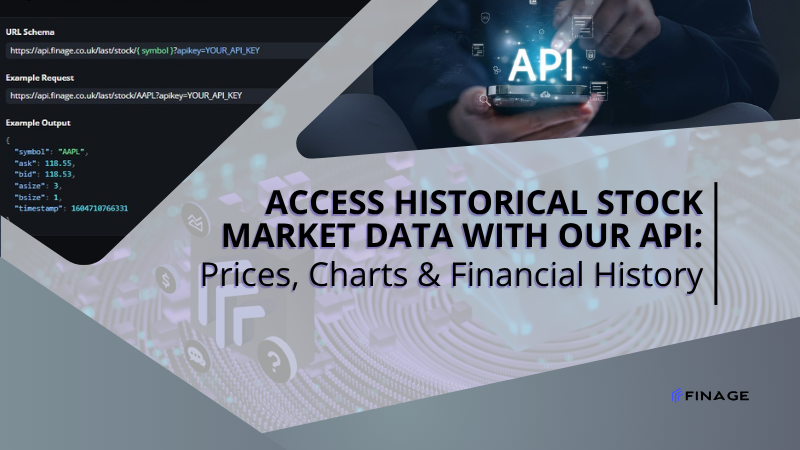Using Streaming APIs to Track Market Sentiment in Real Time
6 min read • July 9, 2025

Introduction
In today’s hyper-reactive financial markets, sentiment moves faster than fundamentals. A tweet, a breaking news alert, or a sudden spike in volume can shift trader psychology in seconds. Traditional data feeds often miss this nuance—or catch it too late.
That’s why fintech developers and quant teams are turning to streaming APIs. These APIs deliver real-time data from various sources—prices, trades, social trends, and more—giving you a live pulse on how the market feels, not just how it performs.
In this article, we’ll explore how streaming data helps decode sentiment shifts as they happen, and how APIs like Finage WebSockets let you build smarter, faster-reacting tools.
Table of Contents
- Why Market Sentiment Now Drives More Trades
- What Real-Time Streaming APIs Actually Offer
- Key Data Types for Tracking Sentiment
- Practical Use Cases for Sentiment-Aware Apps
- How Finage WebSocket API Powers Real-Time Monitoring
- Final Thoughts
1. Why Market Sentiment Now Drives More Trades
Markets aren’t just moved by earnings reports or economic data—they’re increasingly driven by emotion, momentum, and perception. This shift is especially visible in:
- Crypto markets, where a viral tweet can cause price swings before any technical indicator reacts.
- Retail-driven stocks, where communities rally around narratives rather than fundamentals.
- Forex and commodities, where geopolitical headlines can cause knee-jerk reactions within seconds.
The rise of algorithmic trading and retail participation has made speed and sentiment visibility essential. If your data pipeline waits for candles to form or lags behind social trends, your product will always be a step behind.
That’s why modern fintech platforms are investing in real-time infrastructure—not just for prices, but for everything that shapes how people feel about those prices.
2. What Real-Time Streaming APIs Actually Offer
Streaming APIs—especially those using WebSocket connections—deliver data continuously as it happens. Unlike REST APIs, which require frequent polling and may miss fast updates, streaming APIs push new data directly to your app the moment it changes.
For sentiment tracking, this means you get:
- Immediate Reaction to Market Moves
Price spikes, unusual volume, or volatility changes can be detected in milliseconds—giving your platform a chance to respond before the next candle closes.
- Continuous Context
Streaming APIs allow you to build running metrics (like rolling average price or real-time volatility) that update in sync with the market—not on delay.
- Multi-Asset Tracking
With a provider like Finage, you can stream real-time quotes and trades for crypto, stocks, and forex—all through the same channel.
- Better Signal for Sentiment Models
By layering high-frequency trade and quote data with other inputs (social APIs, news sentiment, etc.), your system can detect emerging sentiment shifts before they become obvious on charts.
Streaming data transforms static dashboards into live, responsive platforms. It’s the foundation for tools that don’t just show what happened—but predict what’s about to.
3. Key Data Types for Tracking Sentiment
Market sentiment isn’t always easy to quantify—but certain data streams serve as reliable signals of trader psychology, especially when consumed in real time.
Here are the main types of data fintech apps use to track sentiment:
- Trade Ticks & Volume Surges
A spike in trade frequency or abnormal volume can indicate aggressive buying or panic selling. Streaming APIs like Finage WebSocket deliver these updates instantly.
- Bid-Ask Spread Changes
Narrowing spreads suggest confidence; widening spreads often reflect uncertainty. By tracking this in real time, your app can detect hesitation or momentum among market participants.
- Price Velocity & Micro Trends
Rapid micro-movements—especially when unaccompanied by news—often point to sentiment-driven trades. Streaming prices let you measure speed and direction more accurately than end-of-minute data.
- Correlated Asset Movements
When multiple assets move together unexpectedly, it often reflects macro sentiment shifts. With Finage API’s multi-asset support, you can track these patterns without separate data providers.
While social media sentiment, news analytics, and crowd signals can be layered in, these market-based indicators give developers a clean, quantifiable baseline to work with.
4. Practical Use Cases for Sentiment-Aware Apps
Real-time sentiment tracking isn’t just theoretical—it powers some of the most responsive and user-centric fintech tools on the market today. Here’s how teams are putting it into practice:
- Trading Bots That Adjust to Emotion
Bots that monitor price velocity, spread shifts, and trade clusters can scale risk or pause execution when sentiment swings. This minimizes losses during panic selling or euphoric spikes.
- Smart Notifications for Retail Investors
Apps can alert users when unusual volume or aggressive buying occurs—turning raw market noise into personalized, actionable insights.
- Risk Management Dashboards
Real-time streaming lets portfolio managers see sentiment turn before technicals confirm. This enables faster hedging or portfolio rebalancing.
- Sentiment Heatmaps
By analyzing price pressure and volume shifts across multiple assets, fintech apps visualize market mood shifts regionally, categorically, or by sector.
- Institutional Monitoring Tools
Firms use real-time sentiment analysis to benchmark trader behavior, optimize execution, and detect patterns linked to news, policy changes, or macro events.
The common thread: without low-latency, streaming data, these insights would lag—and by the time they arrive, the edge is gone.
5. How Finage WebSocket API Powers Real-Time Monitoring
Building a sentiment-aware app or trading tool is only as effective as the data powering it. That’s where Finage WebSocket API becomes a critical part of the architecture.
Finage offers a unified streaming solution for stocks, crypto, and forex—all through a single WebSocket channel. This simplifies integration and ensures consistent performance across markets.
Why Finage Stands Out:
- Low-Latency Updates
Tick-level pricing and volume data delivered in milliseconds, ideal for detecting shifts in real time.
- Normalized Symbols
No need to remap tickers across asset classes—Finage uses a consistent symbol format across all data feeds.
- Flexible Subscriptions
Track individual assets, groups, or entire sectors with scalable channel options for different use cases.
- Multi-Asset Coverage
Stream sentiment cues across crypto, equities, and FX without switching providers or writing different logic.
- Reliable Infrastructure
Finage is built for high-throughput applications. Whether you're building mobile alerts or institutional-grade monitoring tools, the data stays live and accurate.
With WebSocket support this robust, sentiment tools can finally keep pace with how fast markets react.
6. Final Thoughts
In today’s trading landscape, how people feel often matters as much as fundamentals. By the time sentiment shows up in technical indicators or end-of-day candles, the real opportunity is gone.
Streaming APIs let you tap into the raw emotion of the market in real time—watching trades spike, spreads widen, or velocity shift. And when paired with strong infrastructure, they unlock smarter alerts, faster bots, and more intuitive user experiences.
With Finage WebSocket API, you don’t just get real-time data. You get the structure, speed, and multi-asset support to actually use it—without managing separate feeds or reinventing your backend.
Whether you're building tools for active traders, retail investors, or institutional clients, one thing is clear:
To understand the market, you need to feel it—live.
Start integrating with Finage today and let your product react as fast as the market does.
Claim Your Free API Key Today
Access stock, forex and crypto market data with a free API key—no credit card required.

Stay Informed, Stay Ahead
Finage Blog: Data-Driven Insights & Ideas
Discover company news, announcements, updates, guides and more


